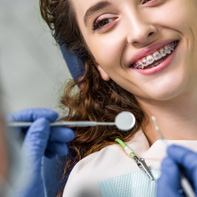Traditional Braces – Canfield, OH
Setting Your Smile Straight

Metal brackets, wires, and rubber bands are what come to mind when most people think about braces in Canfield. While this traditional orthodontic treatment method still offers reliable care using a tried-and-true technique, there have been numerous innovations in the materials and procedures that make traditional braces anything but old-fashioned. Whatever your smile alignment needs, Dr. Mikolich and her team will work with you to create a personalized treatment plan to achieve a healthy and beautiful smile. Contact us to schedule your orthodontic consultation today.

Why Should the Teeth Be Straightened?
Despite what you may think, crooked teeth are not a strictly cosmetic problem that you can afford to wait for your children to grow out of. First of all, when the teeth don’t line up correctly, they are harder to brush and floss, meaning there’s much more of a risk of developing cavities and gum disease. Also, crooked teeth can very easily throw off the alignment of your bite, making chewing and speaking more difficult than they should be. In some cases, it can also put more pressure on the teeth and cause them to wear down unnaturally quickly, meaning they could weaken and break. Getting braces at a young age can help your child avoid these issues. Older patients can also protect their long-term oral health by wearing braces to correct alignment issues.

How Do Traditional Braces Work?
For centuries, doctors have used braces to move teeth into their ideal positions, giving patients perfectly straight, functional, beautiful smiles. Metal and ceramic braces are composed of a series of brackets and wires. The brackets are attached to the front surfaces of teeth and a wire runs between each bracket. Each wire is secured with a rubber or metal ligature Braces slowly move teeth to the proper position by applying a constant, gentle force via orthodontic wires to the teeth. The length of treatment time with braces varies between one to three years and is dependent upon the severity of your case, age, and patient compliance.

What Orthodontic Issues Can Braces Fix?
Braces are capable of addressing many of the most minor and complex dental issues. This is why the traditional bracket-and-wire system is so often recommended.
Bite Misalignment
Worn tooth enamel and chronic jaw pain are just two of the possible problems that can develop when it comes to a misaligned bite. Fortunately, with regular braces, your teeth can move into better alignment, creating a more functional and comfortable bite. Instead of experiencing pain when biting down, you will be able to eat without discomfort and smile with greater confidence.
Crowded & Crooked Teeth
Your smile’s aesthetics will not be the only thing that is negatively impacted by crooked and crowded teeth. Your inability to maintain good oral health will be affected as well. When teeth are positioned incorrectly or lack the necessary space for proper brushing and flossing, bacteria and harmful particles can burrow into the crevices and cause tooth decay. By wearing traditional orthodontics, your braces can create necessary space, generate a beautiful smile, and allow for optimal oral hygiene in the future.
Gapped Teeth
Gapped teeth can be embarrassing for some patients, but the real issue is the potential for cavities. Because of the excess space between teeth, bacteria can become trapped and wreak havoc on your teeth and gums. With regular metal braces, however, we can close the gap and give your smile the chance to thrive.

Caring for Your Braces
No matter the type of orthodontic treatment recommended, there are specific instructions regarding how to properly care for your braces. Whether you have traditional metal braces or clear/ceramic ones, your orthodontist in Canfield is here to provide a few helpful tips:
- Brush and floss regularly. You’ll need to brush twice a day for two minutes and use a floss threader or water irrigator to get between teeth and underneath wires.
- Use an interdental brush if necessary to clean areas underneath wires and between brackets.
- Stay away from hard, crunchy foods to prevent accidental breakage of your oral appliances.
- Wear protective mouth gear when playing sports or an instrument. It can also be helpful should you be prone to grinding or clenching your teeth at night.
- Keep your follow-up appointments with your orthodontist and dentist to ensure a healthier smile throughout your orthodontic treatment.

Clear/Ceramic Braces
You might think that braces are necessarily made out of highly noticeable metal, but that doesn’t need to be the case. It’s possible to make orthodontic brackets out of clear ceramic and then attach them with clear or tooth-colored wires and elastics. The big advantage of clear/ceramic braces is that they can make many of the same corrections as traditional braces just as reliably but without having to compromise your appearance.

Phase 1 Orthodontics
If your child still has some of their baby teeth and none of their permanent teeth, it’s probably too early for them to get traditional braces. However, they could still benefit from a Phase 1 Orthodontic treatment, which can be used to straighten the baby teeth, ensure the proper development of the jaw, and help the permanent teeth come in properly.
Understanding the Cost of Traditional Braces

Traditional braces are a time-tested solution for straightening teeth and improving your smile. While the cost of braces can vary, it’s often an investment worth making. At Mikolich Orthodontics, we’re committed to providing transparency about the cost of your treatment so you can plan with confidence. Whether you’re looking into braces for yourself or your child, our team is ready to guide you every step of the way! For more information about the factors that affect the price of traditional orthodontics, continue reading below.
Factors That Affect the Cost of Traditional Braces

The cost of traditional braces fluctuates from patient to patient because every case is unique in scope and complexity. Here are some of the most impactful factors we look at when deciding your price:
- Treatment Duration: Longer treatment times generally mean more appointments and adjustments, increasing the overall cost.
- Complexity of Treatment: More complex cases may need additional procedures or tools, which need to be taken into account for final pricing.
- Age: Adults sometimes need a different approach for orthodontic care, which may change costs compared to younger patients.
- Treatment Compliance: If additional measures like wearing rubber bands aren’t consistent enough, it could cause your treatment to progress more slowly, which will affect the price.
At our Canfield office, we strive to offer transparent and detailed cost estimates for your treatment plan. We’ll work closely with you to make sure you understand the process of your treatment and any associated costs so there are no surprises.
Professional Braces vs. “DIY” Braces: Which Costs More?

While DIY orthodontic solutions might seem less expensive, they can lead to serious complications and additional expenses down the line. Professional braces, though initially higher in cost, offer long-term value and reliable results with the guidance of an expert orthodontist like Dr. Mikolich. Our team ensures your braces are customized to fit your needs and provides regular check-ups to check your progress.
DIY braces, often made of household items, lack personalized care and planning. Because of this, they often do more harm than good for your teeth, gums, and jawbone, leading to costly repairs. The best way to manage an investment for your smile’s health and appearance is a professional treatment plan, crafted and managed by our expert team.
Does Dental Insurance Cover Braces?

There are few dental insurance plans that include coverage for orthodontic treatment. However, providers that do have these policies are far more likely to cover traditional braces than clear aligners.
Because policies can vary, it’s best to check with your provider directly to ask about orthodontic benefits and the limitations attached to them. If you need more guidance, our team is happy to help verify your insurance coverage and answer questions about your plan!
Options for Making Braces Affordable

At Mikolich Orthodontics, we believe everyone deserves a beautiful smile, regardless of budget. That’s why we partner with CareCredit, a trusted financing solution for all your healthcare needs. With CareCredit, you can break down the cost of your braces into affordable monthly payments, often with low or no interest!
Whatever path you decide to take toward your new smile, we’re happy to help you explore your options for fitting your treatment into your budget. So, reach out to us today to schedule your consultation and take the first step toward a healthy and confident smile!
Traditional Braces FAQs
Am I Too Old for Traditional Braces?
Many patients associate traditional orthodontics with their teenage years because that’s when so many people undergo treatment. However, there are plenty of adults who need them, too. It’s normal for your teeth to shift out of alignment after years of sustained pressure from biting and chewing.
It’s worth noting that as adults, teeth are more firmly embedded in the jawbone, so it might take longer to shift them to their proper alignment. Also, Dr. Mikolich will need to ensure no other issues, like cavities or gum disease, interfere with your results. If she finds any areas of concern, she’ll treat those first and then proceed with braces once your mouth is clean.
How Long Do Traditional Braces Take?
It’s only natural to want to be well informed about a potential treatment before deciding if it’s right for you, and many patients wonder how long they can anticipate wearing their braces. The exact length of time depends on your unique situation, so there’s no one-size-fits-all answer. Dr. Mikolich will examine your mouth to get a better idea of what’s needed, and then can provide more detailed information based on her findings.
Some factors that influence how long you’ll wear braces can include:
- The severity of your condition. Extremely overcrowded teeth or major malocclusions typically take longer to correct than milder cases.
- Your age. Children and teenagers have more flexible teeth and jaws that fully grown adults, so their smiles tend to shift more quickly.
- How well you comply. You’ll need to adhere to dietary restrictions, consistently clean your braces, and follow any other directions that Dr. Mikolich provides to avoid damaging or dislodging your orthodontics, which can extend your treatment timeline.
Do Traditional Braces Hurt?
Anything that applies enough pressure to your teeth to move them can potentially cause aches, and braces are no exception. Once they’re installed, it’s normal to feel sore for about a week, but then the sensation fades as your mouth acclimates to the added force. Then, it’s normal to feel tender again after your follow-up appointments because Dr. Mikolich may need to adjust the archwire to ensure everything stays on track. Typically, it’s safe to take over-the-counter pain meds, like Tylenol or ibuprofen, to address any associated throbbing.
Another common issue is that the sharp edges of brackets and wires can rub raw spots in the tissues inside your mouth. Thankfully, applying a small amount of orthodontic wax creates a smoother surface to keep you comfortable.
What Can’t I Eat with Traditional Braces?
You’ll probably be feeling sensitive when you first get braces, so to avoid triggering any unpleasant sensations, you may want to stick to soft foods that are easier to chew and swallow. Popular options include applesauce, scrambled eggs, mashed potatoes, or yogurt.
Also, you should avoid any ingredients that can damage or dislodge the brackets, such as:
- Overly hard foods like ice, popcorn, hard candy, or ice.
- Sticky sweets like toffee, caramel, or chocolate.
- Nuts and raw fruits and veggies.
- Hard or crunchy breads, rolls, and chips.
You should also avoid chewing inanimate objects like pen caps or fingernails to protect your teeth and orthodontics alike.

